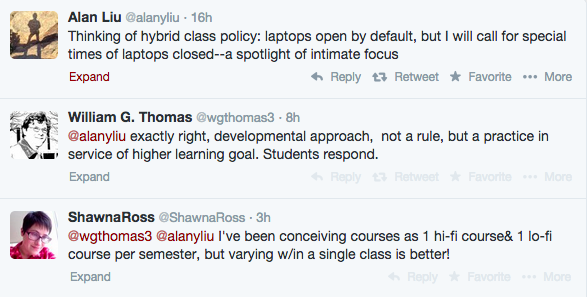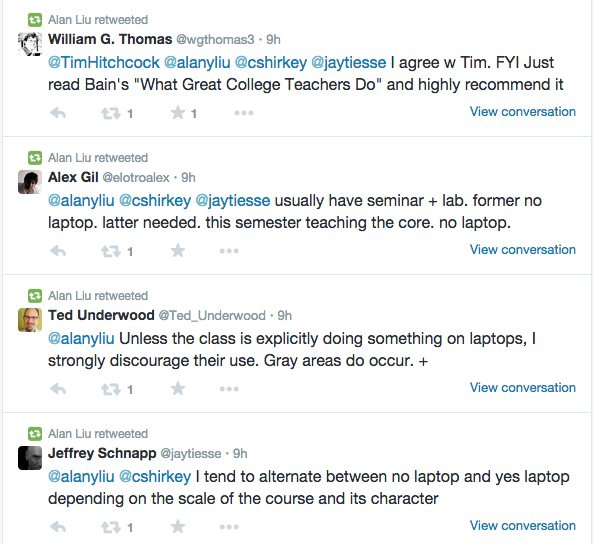Hi-Fi Lo-Fi Teaching
Today, on Twitter, Alan Liu initiated a discussion about hybrid pedagogy following Clay Shirky’s breakout essay, “Why I Just Asked My Students To Put Their Laptops Away”. (I call it “breakout” not because it is breakout for him but within my own socioacademic mediaverse, in which the post has been reposted by those far beyond my “usual suspects” DH pedagogists.) Shirky explains,
Over the years, I’ve noticed that when I do have a specific reason to ask everyone to set aside their devices (‘Lids down’, in the parlance of my department), it’s as if someone has let fresh air into the room. The conversation brightens, and more recently, there is a sense of relief from many of the students. Multi-tasking is cognitively exhausting — when we do it by choice, being asked to stop can come as a welcome change.
For me, the operative concept here in Shirky’s analysis is change, which variously could—or could perhaps not—occur within technology policies. In other words, this no-laptops policy isn’t automatically an argument against technopositivism or for dystopian hand-wringing. It’s about resetting students’ and instructors’ default systems, whether those systems involve texts, discourses, technologies, assignments, whatever else rearranges the economies of attention inside a classroom.
Or between classrooms. I’ve been experimenting this semester with my two face-to-face courses, as I responded to Liu, whose invocation of “intimate focus” reminds me of Ryan Cordell’s candlelit scriptorium:

But I’ve decided that I wanted to take this blog-portunity to take back my unnecessarily fast compromise at the end of my tweet (still having a hard time overcoming gender programming always to be communitybuilding first and assertive second).
Anyway, William G. Thomas’s response also emphasizes that Shirky’s not calling for one-size-fits-all restrictions, and indeed, this semester, I’ve selected my English 101 course (your basic intro to college writing) as my media- and tech-intensive course, while my ENG 222 course (Brit Lit Survey from 1800) is a nearly no-tech course. This alternation between hi-fi and lo-fi classes has made me more keenly aware of the vast range of decisions I make in my classroom, knowing all along, however, that both the lo-fi and hi-fi arrangements boast the affordances that satisfy my requirements for a “good class.”
At 9 A.M. I start English 101 by projecting our course Twitter feed (#SocialMediaPoly) in order to jump-start class discussion about course readings from our physical text. From there we discuss our online readings and their assignments, each of which involves social media components (they compose and critique texts, tweets, statuses, thinkpieces, listicles, online quizzes) as well as a “traditional” essay component. The wired connections of the classroom make us jumpy and lateral and sparky, help us move fluidly between each other and the course readings. What results is a fast-paced, buzzy course that wears me out but leaves students (I hope) feeling a bit more attentive to writing as a technology and technology as writing.
At noon, I walk past a corrugated iron bridge to a jewel-box of a conference room jutting out past the main wings of Santa Catalina Hall. I join my five students along with six chairs, six paper copies of a novel or poem, and a table. Rolling up the blinds over our floor-to-ceiling windows, we enjoy a dreamy northward view that melts gradually out from the soft pastels of the desertscaped ASU Polytechnic campus into the high-contrast drama of the Four Peaks mountain range. In the middle of the desert, yet suspended above a wispy grove of palo verdes, we feel perched over an oasis. The view calms us down, severing us from whatever drama is unfolding on our cell phones and from whatever academic crisis we’ve been facing. When the door shuts, we each belong to the class. The intimacy of the space focuses our attention to each other, we lean back luxuriously in our executive-lite chairs, and what results is the English class of my nineteen-year-old dreams. We talk about how to live a good life.
I have never dared before so baldly to suggest to students that the variously clever structures of poems, essays, and novels construct are like so many treasure maps of the mind. Of course, we discuss, as much as in any other of my courses, the injustices of empire, capitalism, industrialism, racism, sexism, homophobia, heteronormativity, and other evils that undergird the Brit lit canon. We talk about how Jane Eyre instrumentalizes the racially othered Bertha Mason. But we also talk about how Jane feels, and how Jane makes them feel about their feelings, and how those feelings derive from language and storytelling. I feel extremely privileged during those 75 minutes, and it’s safe to say (because my students have said so) that they have been thirsting for these kinds of conversations in their humanities classes. Knowing how much my ethnically and financially diverse students are paying for this opportunity—in money, in time, in social and vocational experience, in their altered relations with their friends and families—I take their satisfaction very seriously. I take their pleasure very seriously.
You have noticed already that it is my pleasure too. Part of me fears that this extreme lo-fi hi-fi alternation is a bit indulgent, perhaps one-sided. But then again, my fellow instructors too have their own approaches, and I will teach many of those students again, so my hi-fi students have plenty of lo-fi classes and vice versa. I realized that students do not need every class of mine to be everything for them. In the past, I’ve wanted to claim the spontaneity and unexpected caché of being wired and wiring a class at the same time moment I claim the suede-patches suavity of teaching English as a method of connecting historically and culturally rich discursive structures to humanistic values. Sure, I think it’s possible to do both, particularly if one alternates between wired and unwired portions of the same course, whether the instructor alternates by course day or within a single course section. So said a range of Liu’s respondents:

For my particular groups of students, my 101 students tend to be engineers and other STEM fields, whereas my literature students are actually English majors. This semester, then, I can justify my hi-fi/lo-fi divide by pointing to my different student constituencies. For the future, however, I’ve been agitating the space people here at ASU Poly to redesign a few of our classrooms to feature 20 computer terminals lined on the three edges of the room with 20 seats at them, next to a traditional projection and whiteboard setup on the fourth wall. In the middle of the class will be rectangular tables pushed together to allow those same twenty chairs to roll away the computers to gather together in a rectangle, or to separate for group work at smaller tables.
I might actually succeed and get this magical room made. The space people are listening. And if I do, I will easily be able to have my diverse group of students have wifi-connected terminals furnished for them when we need them, but arranged in such a way that we can abandon them and face one another at any moment. But for now, I find it immensely relaxing to know what kind of experience I’m trying to secure for which group of students.
In the future I hope to have both capabilities ready to go at all times, but for now, each one of my classes has already evolved its own unique character, and the lo-fi/hi-fi divide has made me more attuned to what my students derive from each environment. In the meantime, I’m going to get this conference room reserved for Spring 2015 as soon as I can.